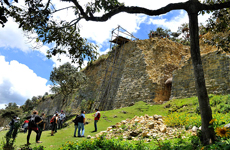| |
| Day 1: Arrival in Lima (mostly in the evening). Accommodation in Lima |
daily program |
| Arrival at the International Airport Jorge Chavez in Lima. You will be welcomed by your tour conductor, who will accompany you to the modern area of Miraflores, and will help you check into your hotel. Depending on your arrival time, you will have time to enjoy dinner at Kennedy Park or walk to the modern shopping center Larcomar, and take a first stroll by the Pacific Ocean. Your local tour conductor is there to help you with any questions you might have. |
|
| Day 2: City Tour and Larco Herrera Museum. Accommodation in Lima |
daily program |
| In the morning, we invite you to join us on a city tour in a comfortable coach. Our visit of Lima, city of contrasts, starts with the colonial heart of the city, with its beautiful mansions with wooden balconies. First you’ll see the Plaza Mayor, surrounded by the cathedral, the Archbishops’ Palace and the Palace of Government. The Cathedral houses the tomb of Francisco Pizarro. Highlights of the San Francisco Convent are its library, choir stall and the catacombs, first discovered in 1951. After your guided tour, it will be easy to understand why UNESCO declared the old town as World Heritage. Lima’s modern districts Miraflores and San Isidro with their attractive buildings, banks and embassies offer many photo opportunities. In the afternoon, a visit to the Larco Herrera Museum is planned. The museum, founded by Peruvian architect Rafael Larco Hoyle en 1926, provides an excellent overview of 3000 years of pre-Columbian history. The museum is located in an 18th century mansion surrounded by beautiful gardens. It features the finest gold and silver collection from ancient Peru and a famous erotic archaeological collection, one of the most visited tourist attractions in Peru. |
|
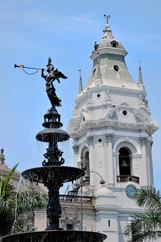 |
|
| Day 3 Caral. Accommodation in Barranca |
daily program |
| Deep in the Supe Valley, about 180 km from Lima, lays Caral, the oldest city in the America’s. It was built in ca 2500 BC, i.e. at about the same time as the pyramids in Gizeh. About 100 people lived here, mainly fishermen, farmers, vendors, craftsmen and priests. The ruins were discovered only a few years ago. During excavations, temple pyramids, utilities, houses and were discovered. Your accommodation for the night will be in a charming little hotel in Barranca. |
|
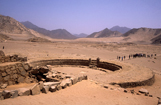 |
|
| Day 4: Paramonga. Accommodation in Huaraz |
daily program |
Before leaving the coastal route to Huaraz, we will stop at Paramonga. Here, the Chimu built a 30-meter high fortress to protect the borders of their empire. Later, the Inca would conquer it. Can you recognize the animal that ‘modeled’ for the design?
Afterwards, our coach will drive up and up into the Andean land. We will drive in the midst of The Cordillera Blanca and Negra (the white and black Andes), crossing the lush Santa valley until we reach Huaraz. This is one of the most scenic drives of your whole trip. Many of the peaks we see are over 6000m high. The Cordillera Blanca is home to Huascarán, Peru’s highest mountain (6768 m) Your body has to get used to these altitudes, so we will have a light program the next day. Always remember not to put your body under a lot of strain and to drink lots of tea and water. |
|
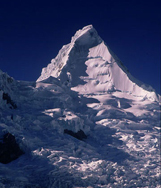 |
|
| Day 5: Chavín de Huántar. Accommodation in Huaraz |
daily program |
| Today we visit the archeological complex of Chavín de Huántar near Huaraz. The Chavín are the earliest, still traceable culture of Peru (12th century B.C.) Chavín de Huántar was one of the most important sanctuaries in the Andes until the late 1600’s. We will pass picturesque villages along the way. Crossing through the Huascarán National Park, you will have a marvelous view on the mighty ice peaks of theNevado Yanamarey und Nevado Pucaraju. In Chavín, you will learn all about how the many buildings were constructed in the rocks. You will also admire a three story high pyramid. Inside, there’s a 4,5 m monolith, with animals depicted on the walls. |
|
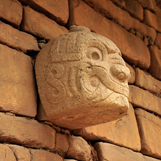 |
|
| Day 6: Llanganuco Lagoon. Accommodation in Huaraz |
daily program |
| The past few days have been all about culture; today nature will be the highlight of your day. Our destination is the Huascarán National Park, where you will be astounded by Carhuaz, Yungay and the lagoons of Llanganuco. We will admire Huascarán, Peru’s highest mountain (6768 m), and mount Huandoy (6428m). Next, we visit the beautiful aquamarine mountain lake Chinacocha. Yet, the Oroncocha lagoon is just as beautiful. The hike between the two lakes takes about an hour. The National Park is also an excellent place to admire the Puya Raymondii, one of Peru’s most impressive plants. They are named after the Italian scientist and geographer Antonio Raimondi, who dedicated his life to the geographical and cultural wonder of Peru. The Puya Raymondii can grow up to twelve meters high. |
|
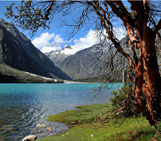 |
|
| Day 7: Cerro Sechín. Accommodation in Trujillo |
daily program |
| We will leave the Andes for now and descend to sea level. We will drive along the Panamerican highway until we reach our destination: Trujillo, also known as the”city of eternal spring”. Before you wind down with a tasty Pisco Sour, we want to show you an important part of our heritage: the archeological complex of Sechín, which consists of four sites. The Cerro Sechín (from around 2000 B.C.) is open to the public. Particularly interesting are the stone carvings on the wall surrounding the temple. They depict a long procession of dignitaries. At the end of the day we will drive to Trujillo, where you will stay overnight. |
|
 |
|
| Day 8: City Tour Trujillo, Sun- & Moon pyramids, Huanchaco, Chan-Chan. Accommodation in Trujillo |
daily program |
| Trujillo was named after the birthplace of Francisco Pizarro. It has quite a remarkable Latin Quarter with old colonial houses. The statue on the Plaza de Armas is a memorial to Peru’s Declaration of Independence in 1820. After a short city tour, we invite you to visit Chan Chan, the formal capital of the Chimú Empire. At the time of the Spanish conquest, it was the largest city in the world, built entirely out of raw adobe. The heart of the ancient city has been partially restored. Places of ceremony, prayer halls, a prison and a burial garden have been displayed. Pay special attention to the marvelous geometric wall ornaments. We will have lunch in the charming fishing village of Huanchaco. You’ll enjoy watching the fishermen going to sea with their original “torora horse”, or reed boats. After lunch, we visit the magnificent Sun and Moon pyramids, both relics of the Moche Culture. At the time of their construction (450 B.C.), they were the largest buildings in the America’s. Today, only a third of the Pyramids remains. The Spanish have washed away more than half when they diverted the Moche River to try and find gold. The pyramids` adobe structure didn’t resist the water well. The Sun pyramid was the administrative apparatus, whereas the Moon pyramid served ceremonial purposes. |
|
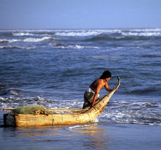 |
|
| Day 9: El Brujo. Accommodation in Cajamarca |
daily program |
| Today, our journey takes us further north to El Brujo, or the “Pyramid of the sorcerer”, also a monument by the Moche. It shows striking similarities to the Moon Pyramid and is famous for its reliefs. The excavations have not yet been finished. In 2006, the grave of the “Señora de Cao” was discovered. This discovery reinforced what had been assumed at the time the Lord of Sipán was revealed: Moche women could hold very high positions, even rule. After the tour, the coach will move up to the highlands again, to Cajamarca. |
|
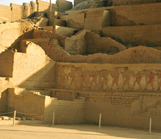 |
|
| Day 10: City Tour Cajamarca, Ventanillas de Otuzco. Accommodation in Cajamarca |
daily program |
| Cajamarca is the only major city in the Northern Andes. It has a rich historical background. The battle of Cajamarca took place here in 1532, when Spanish conquistador Pizarro captured Atahualpa. Even though Atahualpa’s men offered the Spanish the golden treasure they had requested (a room full of gold, which became known as the ‘Ransom room’), Pizarro never intended to set Atahualpa free and had him executed. Then we leave the city for Otuzco. The baths of the Inca will be our starting point, famous for their slightly sulphurous hot springs, where the Inca used to bathe. When the newspaper El Comercio held a survey about the“Seven wonders of Peru”, the baths came out as number one. Departing from the springs, we will then visit the Ventanillas de Otuzco, a sanctuary of the pre-Inca era, which consists of a cell of niches, in which the dead were buried. |
|
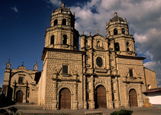 |
|
| Day 11: Cumbe Mayo, hike. Accommodation in Cajamarca |
daily program |
| The archeological complex of Cumbemayo is a 3000 year old aqueduct carved in stone, in the middle of rocks and caves of impressive and yet bizarre forms, which adds to the mysterious character of the place. The hike on the Inca trail (approximately four hours) will take you far from the tourist crowds, to pristine landscapes where lush vegetation and lots of rare bird species can be found. |
|
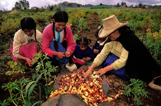 |
|
| Day 12: Journey to Leymebamba. Accommodation in Leymebamba |
daily program |
| The journey from Cajamarca to Leymebamba is one of the most spectacular routes in Peru. We cross two cordilleras of the Marañon-canyon (3.700 m) and pass through several vegetal zones such as mountain cloud forests, deserts and agricultural forests. The deepest point of the journey is the little town of Balsa, where we will cross the Marañon River. We then visit the Leymebamba museum. In the “mummy room”, we will admire the mummies found in the nearby Laguna de Condores lagoon. |
|
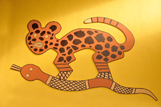 |
|
| Day 13: Revash. Accommodation in Tingo |
daily program |
| Today our excursion will take us to Revash. These famous, colorful burial grounds are located on a cliff, so they are only partly accessible by car. Up from a certain point, our journey will continue on horseback.The Inexperienced shouldn’t worry; the ride is easy and takes about an hour and a half, through beautiful mountain scenery. The tomb is of exceptional architecture, consisting of multi-storied chambers resembling houses and temples, covered with bright red geometrical figures and representations of animals. The paintings on the walls of the cliff stem most likely from an even older culture. After our visit, our horses will take us back to the coach, which will take us to our hotel in Tingo. |
|
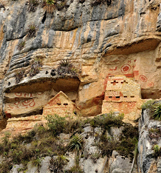 |
|
| Day 14: Kuélap. Accommodation in Chachapoyas |
daily program |
| Today our route will take you to one of the highlights on your tour: Kuélap. The former centre of the Chachapoyas culture is also known as “the second Machu Picchu”, even though it is much older. Surrounded by an immense wall (1,5 km long and 10-20 m high) and located on a mountain crest, it was long hidden by dense vegetation. Kuélap was discovered 60 years before Machu Picchu, but is not as well known, perhaps due to its (even more) secluded, hard to reach location. |
|
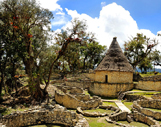 |
|
| Day 15: Journey to Chiclayo. Accommodation in Chiclayo |
daily program |
| Today we bid the highlands farewell and make way to Chiclayo, passing through the “departamentos” Amazonas, Cajamarca, Piura and Lambayeque. The long journey will allow you to ask your tour conductor all kinds of questions and to complete your travel log
... |
|
 |
|
|
| Day 16: Witch market, Sipán, Túcume and Museum Tumbas Reales de Sipán. Accommodation in Lima |
daily program |
| After a stop at the witch market, we visit the archeological complex of Sipán. Sipán is the most important archeological site in the country. In 1987, “Lord of Sipán” burial grounds were discovered here. The Moche leader (200 B.C.)was buried with his servant and bodyguard. Fine ceramic jars held food and drink to sustain him on the journey to the next life. Afterwards, we’ll visit the valley of pyramids near Túcume, 26 enormous adobe pyramids have been discovered during a vast archeological expedition. We also visit the Royal Tombs of Sipán museum in Lambayeque, the most modern museum in the America’s, built after Moche guidelines. Afterwards we will bring you to the airport for your flight to Lima. Upon arrival, you will be greeted at the airport and accompanied to your hotel. |
|
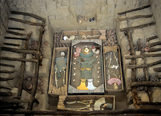 |
|
| Day 17: Flight home |
daily program |
| You’ll have the morning at your free disposal for last minute shopping and chores. After a farewell lunch with the group in Peru’s most famous restaurant (located on a pier above the Pacific Ocean), we will accompany you to the airport for your connecting flights. |
|
|
|
|
